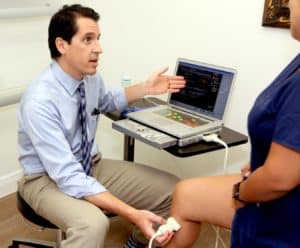Sitting for extended periods of time is known to have negative effects on your veins and that is especially true if you travel by plane a lot. Being immobile and sitting in cramped spaces during a long flight can cause blood clots and potentially develop deep vein thrombosis (see examples). This is where your blood pools in one area and forms a clot as a response. Usually, these clots will go away on their own but in some people, they can cause some serious health issues. Thankfully, there are some ways to help prevent these clots.
Here are some frequent flyer tips to help keep your legs and veins safe while flying.
Stay Hydrated
In the rush of travel, many people forget to drink enough water. Your body needs adequate water for proper blood flow and circulation. People tend to consume other types of beverages like alcohol or coffee, which can make you more dehydrated so it is important to drink plenty of water before and during your flight.
Stand Up or Walk Around
Standing or walking up and down the aisle is a great way to prevent your blood from pooling in your legs. This keeps the blood flowing and can reduce the chance of blood clots. You can also walk before and in between your flights to keep blood circulating which is another great way to minimize the risk of blood clots. Have a layover? Make sure to take a brisk walk through the terminal (but don’t miss your connecting flight!)
Perform Stretching Exercises
If you are not able to stand or walk, performing stretching exercises in your seat can also help. Stretching the muscles in your legs especially flexing your calf muscles will promote blood flow to that area. Pointing and flexing your foot for a number of times every 20 minutes or so can reduce the chance of blood clots.
If your legs are swollen and painful after your flight, it is important to seek medical attention. With the use of a vein ultrasound, if you have a blood clot, a medical professional can locate and determine the size of the clot and take the necessary steps to treat it. Again, most clots are not serious but if you develop deep vein thrombosis, this could lead to pulmonary embolisms and will need to be addressed right away as they have the potential to be life-threatening.

Symptoms Of A Blood Clot
- Swelling of the ankle, calf, or leg
- Skin that is warm to the touch
- Discoloration or redness
With pulmonary embolisms, you may experience chest pain and shortness of breath which will need medical attention right away.
Risk Factors
- Age (over 60)
- Diabetes
- Obesity
- Recent Surgery
- High Blood Pressure
- History of Blood Clots
- Pregnancy
- Oral Contraceptives
- Smoking
- High Cholesterol
Making sure to stay hydrated and to walk or stretch your legs can significantly help reduce the chances of blood clots. These tips apply for all flights but mostly long haul flights that are 8-10 hours or more where you are stationary for a much longer period of time.
If you have any questions, check with your doctor or a medical professional if you have any concerns about your health before you fly.


